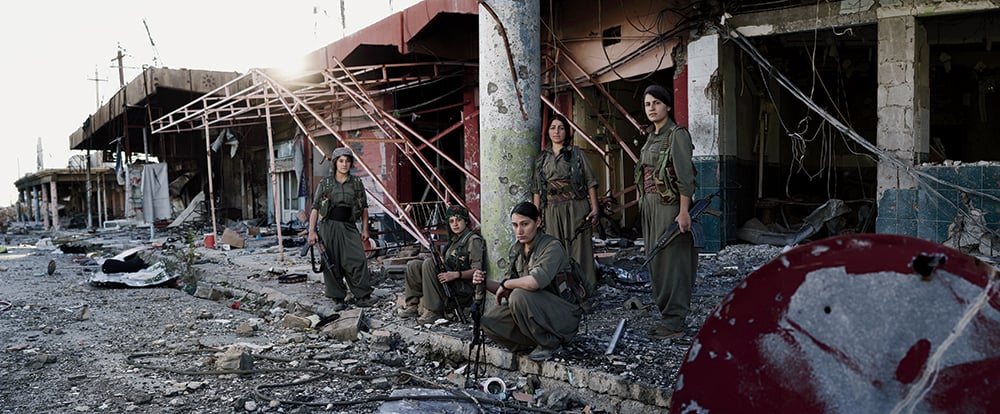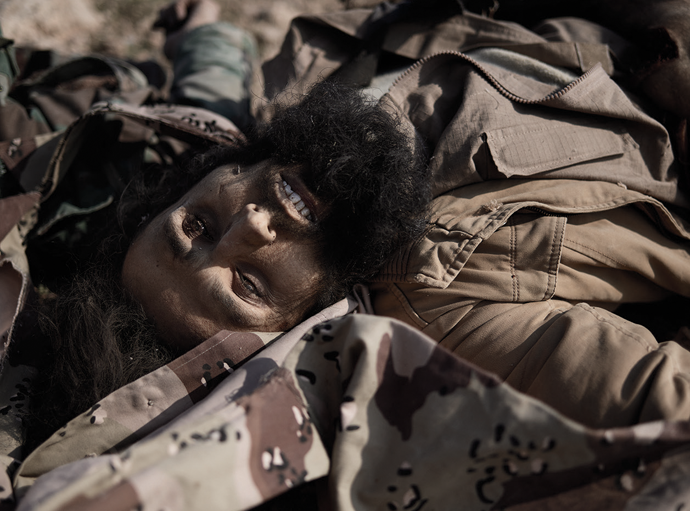Ihave had many names, but as a sniper I went by Azad, which means “free” or “freedom” in Kurdish. I had been fighting for sixteen months in Kurdish territory in northern Syria when in April 2015 I was asked to leave my position on the eastern front, close to the Turkish border, and join an advance on our southwestern one. Eight months earlier, we had been down to our last few hundred yards, and, outnumbered five to one, had made a last stand in Kobanî. In January, after more than four months of fighting street-to-street and room-by-room, we recaptured the town and reversed what was, until then, an unstoppable jihadi tide. In the battles since, we had pushed ISIS far enough in every direction that crossing our territory was no longer a short dash through the streets but a five-hour drive across open country. As we set out to the north, I could make out the snowy peaks in southern Turkey where they say Noah once beached his ark. Below them, rolling toward us, were the wide, grassy valleys and pine forests of Mesopotamia, the land between the Euphrates and the Tigris where our people have lived for twelve thousand years.
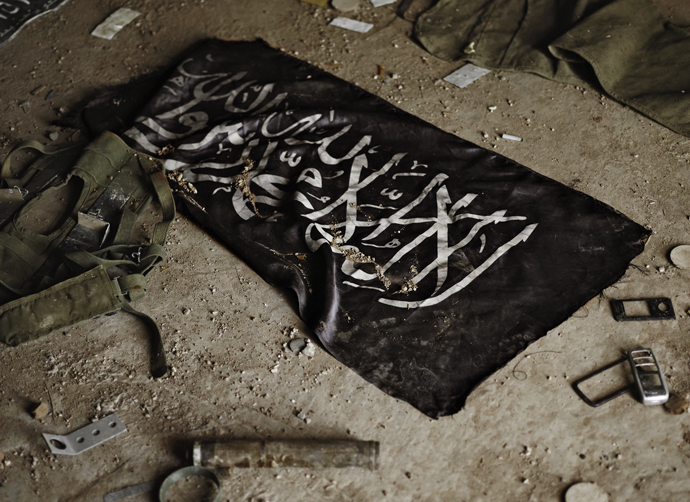
The Black Standard, a flag commonly flown by jihadists, in an abandoned ISIS base, Syria, March 2015. All photographs by Joey Lawrence from his monograph We Came from Fire: Kurdistan’s Armed Struggle Against ISIS, published by powerHouse Books © Joey Lawrence. Courtesy powerHouse Books
The story of my people is filled with bitter ironies. The Kurds are one of the world’s oldest peoples and, as pioneers of agriculture, were once among its most advanced. Though the rest of the world now largely overlooks that it was Kurds who were among the first to create a civilization, the evidence is there. In 1995, German archaeologists began excavating a temple at Göbekli Tepe in northern Kurdistan. They found a structure flanked by stone pillars carved with bulls, foxes, and cranes, which they dated to around 10,000 bce. At the end of the last Ice Age, and seven thousand years before the erection of Stonehenge or the pyramids at Giza, my ancestors were living together as shamans, artists, farmers, and engineers.
If the great strength of the Kurds was their resilience, their great blight has been the greed and laziness of others who, as far back as anyone can remember, have wanted our farms and markets for themselves. For the last few millennia, our people have been conquered by a succession of outsiders including Persians, Romans, and Ottomans. The first Kurdish uprising happened in 838; there have been dozens since. Despite possessing our own language and culture, and a population of an estimated 45 million—ranking us, alongside Argentina and Uganda, as the thirtieth most populous nation in the world—today our people and nation still pass unrecognized as either a people or a nation, split between what others call southern Turkey, northern Syria, northern Iraq, and northwestern Iran. In each of these misnamed, amputated limbs, Kurds are oppressed. Intermittent bans outlaw our language, dress, folklore, names, and, in Turkey, even the words “Kurd,” “Kurdistan,” and “Kurdish.” (We are, instead, “mountain Turks.”)
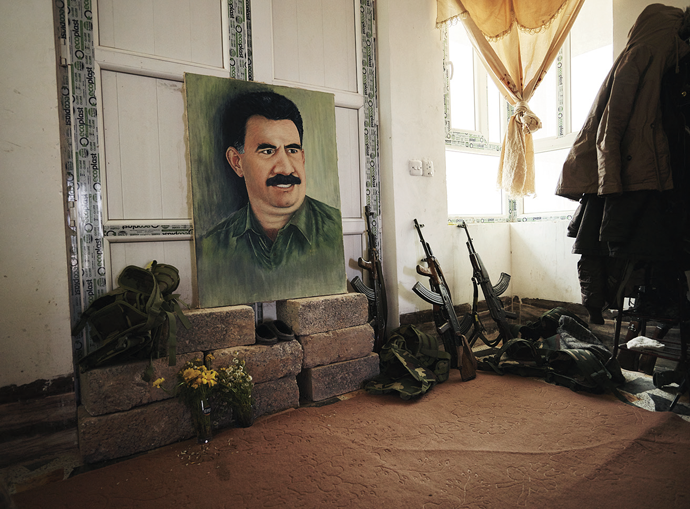
A portrait of Abdullah Öcalan, Sinjar Mountains, Iraq, March 2015
The old farmer’s pickup in which I was traveling was in terrible condition—no suspension or lights or much tread on its tires—and the roads were rutted and slippery. I am not sure we managed more than twenty miles an hour the entire journey. At one point, we came across a group of our female comrades sitting around a fire and stopped for a glass of black tea. Finally, at eleven at night, we arrived at a small settlement of fifty mud-walled houses, some of them bearing the familiar signs of invasion: bullet holes, RPG splashes, and the jihadis’ black graffiti. There I was asked to a briefing with the Commanding Comrade, General Medya.
Medya was in her thirties and a veteran of more than a decade of fighting. She went into battle with her long black hair tied back in a ponytail and a green scarf tugged down above her one working blue eye. One thing that outsiders always find surprising about the Kurdish resistance movement is our insistence that women and men are equal in all things, including war. We believe in the teachings of Abdullah Öcalan, the leader of the Kurdistan Workers Party, or PKK, who wrote, “A country can’t be free unless the women are free.” He also wrote that “the 5,000-year-old history of civilization is essentially the history of the enslavement of women.” He believed that all the inequality, despotism, fascism, and militarism since Neolithic times, when society was matriarchal, stemmed from the moment that man used his physical strength to usurp and denigrate woman. Man violently replaced notions of collective welfare and common ownership with private enterprise and exclusive property. Shamans and religious leaders entrenched this misogyny with faiths based on divinely ordained male dominance. Soon, Öcalan believed, religion was based around a single male God, states were structured around a male-dominated hierarchy, and economies were built on men’s ability to earn. Sexism and power, at least as humanity has known them for five thousand years, have been more or less the same thing. What Öcalan called “housewifization” was, he said, the oldest form of slavery and “the vilest counterrevolution ever carried out.” For the same reason, he counseled, “The solutions to all social problems in the Middle East should have women’s position as their focus.”
In our People’s Protection Units, a volunteer has to be eighteen to pick up a gun, but otherwise all that matters to us is whether you are sharp and useful, not where you are from and certainly not the accident of your gender. Men and women fight alongside each other in separate entities: the YPJ, or Yekîneyên Parastina Jin, for women, and the YPG, or Yekîneyên Parastina Gel, for men. And the women fight, kill, and die as hard as the men, as ISIS can attest. We often talked about how confused the Islamists must have been to find a woman standing over them in their last moments. If they left this earth in doubt, then it made us doubly sure that we were the perfect army to defeat them.
Medya began by saying that the day of our liberation was at hand. The moment we took back the last yard of our homeland would be the one in which we saved our people. It would also be the day that civilization and progress triumphed over the medieval backwardness of the jihadis. Though they would never admit it, we would be achieving what the great nations of Europe and the Americas could not. And with our victory, we would finally bring due attention and support to our cause of an autonomous Kurdistan. For that great day to arrive, said Medya, these last advances had to succeed. Our next immediate objective was a fortified ISIS base on a hill outside the northern Syrian city of Sarrin. Taking it would be best done at night, and that would require a sniper with a thermal scope to lead the attack. “The hill you are to capture is about two kilometers in this direction,” Medya told me, pointing to the south. “To take it, you must first climb another one next to it from where you can fire across at them.”
Medya led me over to meet the small team I would be taking. Leaning up against a wall holding a Kalashnikov was Xabat, perhaps twenty-one, who spoke clearly and with great enthusiasm and who earlier that day had scouted the hills we were to attack. There was a second man with a Kalashnikov—dark and skinny—who said nothing. There was a short, strong woman with a round face, called Havin, who carried an RPG launcher. She had a loader, a nineteen-year-old man who carried her spare rockets and radio. Completing the squad was an older guy, Shiro, twenty-eight or twenty-nine, skinny, tall, and unshaven with long thinning hair, who carried the BKC, a 7.62-caliber machine gun. It felt like a good team.
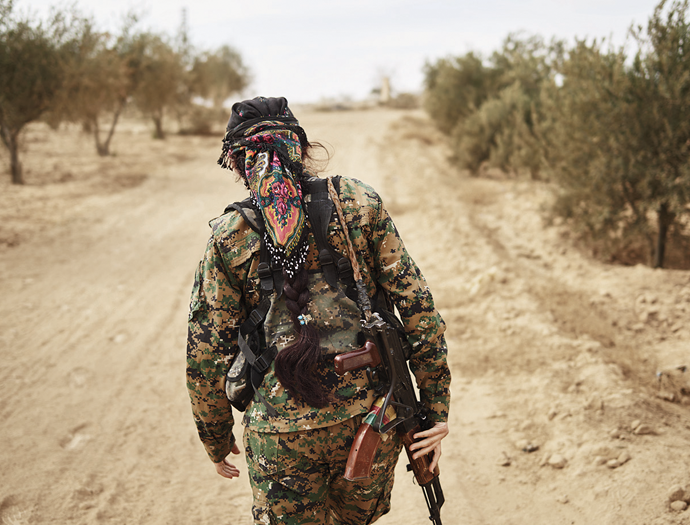
Commander Rojda Felat leads her YPJ unit toward a frontline position, Syria, November 2016.
Any competent soldier can learn the basics of sniping in an hour. The scope of a standard sniper rifle has a crosshair in the center and, to the left, a curved graph with distance on the vertical axis and a flat line representing the ground on the horizontal one. The marks in the horizontal crosshair are for wind. We carried pocket tables into battle on which we could read off how far to shoot to the left or right according to the wind’s strength, its angle, and the range.
Every rifle has its own character and power, and a sniper must learn each one’s temperament. Different tools are also suited for different tasks. M16s, for which we had a handful of thermal scopes, were for nighttime and close-quarters fighting. Dragunovs were for daytime and longer distances. Zagros rifles, which were as tall as a man and mostly built from spare parts, were for day shots of a kilometer away or more.
You also need to know each gun’s firing mechanism. Any weapon can jam, and since turning on a light at night is a good way to be shot, we were taught to take apart and reassemble each gun in the dark. Practicing with rifle parts, disassembling and putting the mechanism together again over and over, had the added advantage of teaching you why touch is a sniper’s most important sense after sight. It is through your trigger finger that you communicate with your rifle. It is through it, too, that you learn the different action of each weapon. The trigger of an M16 fires quickly. A Dragunov has two parts to its pull—a long, slow draw to the firing position, then a short final squeeze. A Zagros has a hair trigger. The importance of the trigger finger is why snipers go to such lengths to keep their forefingers shrouded and unbruised, and why so many cut the finger off a glove to better connect with their weapon. After a while, I learned to recognize other snipers by their whiter, cleaner, smoother forefinger.
Since each gun takes a different caliber of round, a sniper needs to be familiar with their different impacts. Because M16 rounds are much smaller, they often pass right through a target without much immediate effect. Days later, however, an M16 round can prove to be the deadliest of any, since a tight, narrow bullet hole is hardest to clean. The larger Dragunov bullet is often fatal on impact, but if a target survives, his chances of recovery are often better. Zagros rifles fire .50-caliber rounds the size of a fountain pens that can pass through several walls and still kill you. If you are hit by a .50, survival is unlikely and is generally achieved only after the amputation of an arm or a leg. Snipers generally consider Zagros rifles and Dragunovs more honorable weapons than the M16. The first two are designed for clean kills. The M16 is designed to wound and trap the enemy in a dilemma: rescue a fallen soldier and risk being shot, or stay hidden and let a friend bleed to death.
I honed my craft in northern Syria. For eight months, I shot long-distance, alternating between a Dragunov and a Zagros. We had two front lines, one facing south of Qamishli, the other confronting the east and the border with Iraq. On both fronts, the fighting was sporadic and conducted across open no-man’s-land. Initially, I was stationed at al-Yarubiyah, the name we gave our eastern front in the stony desert and dried-up riverbanks that lay in the shadow of the Sinjar Mountains. We were billeted in a new five-story administrative building. I built a hide in a toilet on the roof, hanging my Zagros from the ceiling by a strap so that it was suspended in the air and pointed through the window at the ISIS position about a kilometer and a half away.
During my first few days on the front, the constant fzzz of bullets overhead made me tense up and blink. Every now and then ISIS would start up a mortar barrage, and I would grab my rifle and run down a floor inside the building. Even when I had time to fire, I mostly missed. If I was startled during my shot, as often happened, the bullet would veer wide to the left. A rushed shot meant it skewed right.
I soon learned not to blink or flinch. But mastering my breathing took longer. As you prepare to shoot, your breathing must be almost like meditation. You start with a chest full of air. You breathe out half of it as you line up your sights on your target. At that point, you pause for up to six seconds. Too much air and you’ll shoot high. Too little and you’ll tip forward, and the bullet will go low. The idea is to slow your heart and blood so that nothing, not even your pulse, shakes your aim. For the same reason, you hold the rifle to your bones, not your flesh. Through these five or six long, deep, calm seconds, you stay focused on the target, squeezing your trigger. You fire almost without realizing. The slower and stiller you are, the truer the bullet leaves the barrel.
I started hitting the enemy after a week or so. From my position on the roof, I could see a hospital building inside Iraq where ISIS had placed a tripod-mounted Dushka heavy machine gun. A Dushka could shoot through several buildings and still kill one of ours. If my overall mission was to stop the ISIS attacks, my daily preoccupation was taking down the Dushka operator. Each morning, I would wait for the Dushka to open up, after which I would return fire and shut it down. I fired at that gun for weeks. I must have hit more than a dozen men behind it.
I had other targets, too. One time, during an ISIS advance, I fired more than twenty times at a pickup that was dashing back and forth along a road more than a kilometer away, only for an American jet to sweep in, fire a rocket, and send the vehicle flying through the air. That was the first I knew that the United States was supporting us with air strikes.

Map by Enrique Moreiro.
As I became more experienced, I realized that sniping was as much about human observation as shooting skill. Through the scope, I learned to be able to size up my enemy at a glance: the way he held himself, the way he walked, whether he was confident with his rifle, whether he was careful with his approach, how long his beard was. If I caught a glimpse of someone walking loosely, with his hands hanging down by his knees and his shoulders collapsed—someone who was weak and without purpose or hope—I knew that was someone who was going to make a mistake, and that our advancing team should direct their initial attack at their position. On the other hand, a jihadi who had real purpose, who moved like a mouse, popping up and down, and checking all around himself—he was going to be much harder to shoot but was also more likely to be someone of stature, and therefore a more important target.
When I was going after a truly high-value target, such as another sniper or a high-ranking officer, I would try to create a portrait of my target: who he was, how he behaved, how old he was, what time he woke up, whether he preferred the cold of the morning or the heat of the day. From these studies, it was possible to make some predictions about where and when my enemy would show himself and how to position myself to take advantage. It required total concentration. I had to observe all the information I could, analyze it in an instant, and draw a conclusion about where to aim and when.
My enemy, who knew I was watching them, often tried to frustrate my observations. They would stay hidden, erect curtains, and build corridors through homes, firing through holes in the walls. It was like boxing. You sized up your opponent, waited for your opportunity, and eventually took your shot. Many times, I had to go by what I heard, not what I could see. On more than one occasion, my target looked right at me and even waved. Some played games, running into view, then stopping for a split second, then running again.
Often the idea of these games was to tempt me into giving away my position by firing. Another ISIS tactic was to try to spook us by enforcing a silence. At those times, every sound the wind made—blowing through my hole, shaking the corrugated roof, causing the clothes on the washing line to sway—would become so loud. The idea was to give us too much time to think. What were they doing? How come I couldn’t hear them? Were they going to attack?
Since our enemy was also watching us, we practiced our own manipulations and deceptions. We dug holes in walls through which to shoot, then dug new ones in less likely positions—close to the ceiling or hidden by a shadow—to fool ISIS into targeting the unmanned ones. We dampened our holes with water so that our shots didn’t kick up dust and reveal our positions. We switched lights on and off in places we didn’t use. We left signs of movement in corridors through which we never passed. We even used mannequins to confuse the enemy. Often I found I had success in lining up a shot, then persuading my enemy to walk into it by pretending I was somewhere else. I’d take down one man, then wait for his friend to run out, too.
After a few months, I found that my instincts had augmented and sharpened. I acquired the ability to judge distances to within a few meters without the aid of a scope. I learned to distinguish the various sounds, sights, and trajectories of different bullets. I found enemies with my eyes, my ears, and even my nose. I also developed my own technique for scanning an area, standing square onto the range and closing my eyes, then opening them again, then closing, then opening. Repeated three or four times, I found this camera-shutter technique would print an image onto my mind that I could then examine at leisure for anything unusual, almost as though I were looking at a picture in my hands.
For a daytime assault, a sniper picks a high place such as a building or a hill and covers the advancing soldiers from behind. At night, however, a sniper with night vision leads the attack because only he can see the target. The night we captured the ISIS base on the hill outside of Sarrin, the moon was just a thin crescent. Everyone on my team would be blind, except me.
To advance to the first hill, we followed an established procedure. I walked ahead two or three hundred meters, checked that it was clear, and, after finding cover, signaled for the others to join me. We repeated this maneuver seven or eight times and were around five hundred meters from the first hill when we came under fire. I could hear the sharp, hollow sound of gunshots in the distance, then fzzz! fzzz!, like the sound of a honeybee, as the bullets passed overhead. Though the incoming fire forced us to drop to a crawl, in other ways it was useful. We had been quiet on our approach, which meant that ISIS had to have night vision to have been alerted to our advance. If their bullets were passing over our heads, it suggested that the jihadis didn’t have night scopes on their weapons but just a pair of binoculars. The sound of the fire also indicated only a handful of men, ten at the most, which meant we were evenly matched.
At 1:30 am, still under fire, we reached the top of the first hill. I could see there was a cairn at the summit where farmers had stacked the stones they cleared from their fields. I stopped about fifty or sixty meters before the rock pile and called Xabat to join me. “It’s probably booby-trapped,” he said as he crawled up to me.
Leaving the team behind a boulder, I stood up, quite openly, and in full view of the ISIS fighters, walked briskly toward the cairn. When I reached it, I stopped for a moment to make sure they had seen me. Then I dropped down as though I were taking cover and crawled back the way I had come. Back behind a rock I waited. If ISIS had mined the cairn, they would wait for all six of us to assemble next to it before they detonated it. In the end, the jihadis waited seven full minutes.
An explosion up close initially feels like your inner ears are being peeled. A split second later, you suffer a mini blackout as the blast wave hits your brain. You must keep your mouth open to allow the pressure to travel through you. If the detonation is nearby, you will probably reboot to discover that you’re flying through the air like a rag doll, your nose, eyes, and mouth filled with dust. If you are farther away, it will be the earth that you feel bouncing. Next comes a shower of pebbles. Through all of it, there is nothing to do but close your eyes and trust your luck. If you are going to die, it will be quick, since you will have been caught by the blast or hit by debris or smashed up against a wall or a rock. If you find yourself conscious and hugging the ground, unless something heavy lands on you, you’re going to live.
Through the dust, I could see Xabat grinning. “I told you it was a booby trap,” he said.
The team came up behind me and, as one, all six of us moved forward to what was left of the cairn.
At our new position, I told the others to place a few stones in front of them for cover. I took three rocks, arranged them under my rifle, and pulled my scarf tightly around my head to hide the light from the night scope. Once I was satisfied it was concealed, I turned it on.
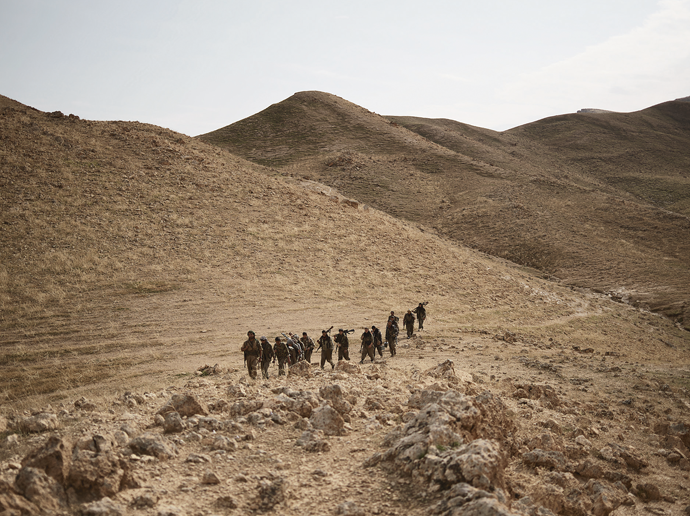
PKK guerrillas and YBS fighters return after a nightlong battle with ISIS, in the Sinjar Mountains, Iraq, November 2015.
I saw them immediately. I could make out a rock-walled base on a slope near the top of the hill opposite us, about 550 meters away. A skinny figure was standing a few meters below the base, and three more men—one tall, one medium in height, and a stocky man dressed in a long flowing shirt—were grouped together a few feet away. The skinny man was talking. The other three were listening. All four were out in the open.
The skinny one is the commander, I thought. He is giving instructions. He is in charge.
Five hundred and fifty meters is close range for a sniper. There was no need to adjust for wind. With a bullet traveling at 762 meters per second, the round would hit Skinny three quarters of a second after it left my barrel. I went for Skinny’s head.
Through my scope, I saw Skinny’s head jerk and his legs fall open. Then he slumped limply against a rock, his head on his chest.
I turned to the other three jihadis. Tall was trying to take cover behind some stones to the right. Medium Size and Long Shirt were running back up the hill toward the base. Medium Size stopped for a second. I aimed for his chest and fired. Medium Size went down.
Long Shirt was still running away up the hill. I followed him in my sights. When he stopped to pick up a large machine gun, I aimed for his body. The sound of my shots echoed off the rocks as Long Shirt went down.
I looked for Tall. He was over to the right, jumping from one boulder to another. He fired back at me, but his aim was wild. Behind the rocks, I could see part of his head and chest and one of his legs. I went for the leg. Tall fell to the ground, then started dragging himself to cover.
Now I could see a fifth man, short and fat, inside the base. Every now and then Big Man would peek out over the wall, his round head appearing for a second, then he would disappear. I shot at him twice but he kept vanishing. He would show himself, fire a burst, disappear, then reappear at another place and fire once more.
I shifted my view back to Tall. He was crawling in the dirt. He might have been trying to flank us. I told Havin, our RPG gunner, to move forward so that she would have a clear line of fire down the hill should he try to come up at us. I waited several minutes until Tall’s head appeared between two rocks, then fired. His head tore away, pulling his body into a somersault and flipping him on his back. Tall was finished.
To the left, I could see that Long Shirt was moving again, trying to hide behind a boulder. I switched my M16 to rapid-fire to scare him into the open. I fired a burst, then another, then a third. But when I went to shoot a fourth time, my weapon jammed.
I removed the magazine, took my cleaning rod from my pack, lowered it into the gun, pushed the bullet out, put the mag back in, and pulled the mechanism back to a firing position. Once again, it failed to load.
I turned off the scope, sat back on my knees, took off my head scarf, and smoothed the material on the ground in front of me. Then I closed my eyes and exhaled. Keeping my eyes closed as we had been trained, I picked up the gun, removed the magazine, detached the stock, trigger, and pistol grip from the barrel, then separated the charging handle and finally the bolt carrier. I laid everything in order on the scarf. Then I reversed the order—bolt carrier, charging handle, stock, trigger, and barrel—until I had put the gun back together again. As I was finishing, Big Man seemed to see me. He began shooting, his rounds slapping the rocks around me, sending burning needles of stone into my left leg.
The disassembly and reassembly took me two minutes. I opened my eyes and pulled back the release. There was nothing wrong with this gun. I put the magazine back in, and through the noise of Big Man’s assault, heard the faint twang of a loose wire coil. That was the problem. If the magazine’s internal spring had come loose, it wouldn’t be pushing cartridges into the breech. I released the faulty mag, put it to one side, picked up a fresh one, slid it in, and pulled back the release. Shtick! The exquisite sound of a round being securely chambered.
My pause had given Big Man and Long Shirt time to breathe. Their bullets were coming in regularly now. A rocket grenade roared over our heads and exploded just behind us, the blast rinsing us with dirt and shingle. Xabat stood up and returned fire. Shiro started firing the BKC. I shrouded myself with my scarf once more and turned my scope back on.
Long Shirt had moved twenty to thirty meters down the hill. I fired the moment I saw him. He went down clutching his head and crying out: “Allahu Akbar! Allahu Akbar!” This was their battle cry. But Long Shirt’s voice was weak, and I guessed he was bleeding out.
To the left, I saw some movement from Skinny. He was on his back. One leg was lying flat on the ground, but the other was moving up and down. I fired at the still leg. The other one kept moving, then dropped abruptly to the ground. Skinny was finished.
We had been in combat for fifty minutes. Four enemy were down. Only Big Man remained. I asked Havin to fire at the walls behind which he was sheltering. With her first rocket, she hit the corner. The next went over. The third just below. I told Shiro to advance fifty meters down the hill and open fire. Then Big Man would return fire and show himself, and I would have him.
Shiro did as I asked, Big Man stood up, and I fired—but again he was too quick, ducking back down before I could get off my shot. Big Man was defending himself well. He fascinated me, in a way. His comrades were all dead. But he was not leaving his position.
Xabat suggested that he and Shiro crawl around behind the base and attack it with grenades. It took them twenty minutes to reach the bottom of the hill. I kept firing so that Big Man stayed low and did not spot them. But he guessed the plan anyway. When Xabat and Shiro were a hundred meters in front of him, he detonated another mine. From my position, the explosion appeared to go off underneath them. But when the smoke cleared, I could see them crawling uphill, still unharmed.
When our men began circling around behind him, Big Man heard them. It sent him into a panic. He kept sprinting outside, trying to spot them in the dark, then running back. I was following him and harassing him with short bursts, trying to make it impossible for him to shoot. When Xabat and Shiro were less than thirty meters behind the base, they called to me to fire more.
As I shot several bursts, Xabat and Shiro ran toward the base and threw two grenades inside. There were two explosions. We waited for a minute. Silence.
I picked up my rifle, walked down the hill and up to the ISIS positions. Skinny, whom I had taken to be the commander, turned out to be the youngest. I had shot him in the head and the leg. Tall, Medium Size, and Long Shirt were all in their late thirties. I had hit Tall three times: in the leg, the chest, and the head. Medium Size had bullet wounds in his shoulder, kidney, stomach, and knee. I had hit Long Shirt in the head and chest. What remained of Big Man after two grenades suggested that he was the oldest, perhaps fifty, and probably in charge. He had died a captain’s death, going down with his men.
Medya released me from duty, and I walked alone back over the hills, through the boulders and thorn scrub that filled the valleys, until I arrived back at the village where I had left the pickup. I packed up my gear, and we drove the five hours back to the eastern front. The sky was brightening, and through the morning fog I could see Sarrin in the distance. In the still of the dawn, with the battle ebbing, there was a tranquility to the way these southern flatlands rolled gently down to the Euphrates.
In our movement, we trust each other to do the right thing. I knew it was my duty to fight on. I also knew my experience was needed. Over the past year, fighting had become so easy for me. Night after night, day after day, month after month, I had lain behind my rifle. Through scorching summers, chilling autumns, endless winters, and wet, numbing springs, I had kept the enemy in my crosshairs. I had burned my eyes with looking. I had survived other snipers, gun attacks, suicide bombers, tanks, mortars, rocket grenades, booby traps, trip wires, stray air strikes, artillery strikes, heavy machine guns, and remote-controlled mines. On a diet of scavenged cheese, jam, the occasional yogurt, and biscuits, I had wasted down to the weight of a thirteen-year-old boy. Without sleep, I lurked in the abyss between adrenaline and exhaustion. So many of my friends had died that I had acquired a new, unwanted duty: to survive, to keep their memories alive. Observing, waiting, shooting—I packed all of life into that tight existence. If you had seen me back then, carrying my trigger finger through the sharp edges of war as though it were a baby, you would have understood that human beings can survive almost anything if they have purpose.
But lately I had begun to think that I had nothing left. I felt as though I had used up thirty or forty years of life in months. I was losing the ability to feel the passing of days. One misjudgment, one push too far, and the darkness would consume me. Climbing up to the ISIS base outside Sarrin, I felt myself falling asleep on my feet. Twice my team had called over to me as I drifted off to the side. At one point, Xabat had challenged me with his gun raised, suspicious of this wandering figure way off among the stones.
I had been back in my old position on the eastern front for a few days when General Tolin came to visit. “It’s good that you are here,” she told me. “We need you here. How are you doing?”
“Coping,” I said.
Tolin nodded and sucked at her teeth. She looked off to the horizon. After a while, she said, “Coping’s not enough, Azad.”
I tried to reassure her. “I can stay here,” I said. “Here is okay for me.”
Tolin regarded me for a moment. She had made up her mind.
“You go back to Kobanî,” she said. “I will see you there.” And like that, my war was over.

